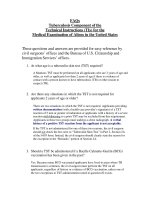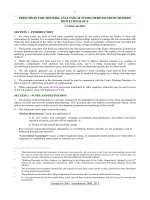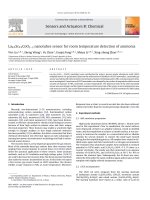Disposable screen printed sensor for the electrochemical detection of delta-9-tetrahydrocannabinol in undiluted saliva
Bạn đang xem bản rút gọn của tài liệu. Xem và tải ngay bản đầy đủ của tài liệu tại đây (1.68 MB, 11 trang )
Wanklyn et al. Chemistry Central Journal (2016) 10:1
DOI 10.1186/s13065-016-0148-1
RESEARCH ARTICLE
Open Access
Disposable screen printed
sensor for the electrochemical detection
of delta‑9‑tetrahydrocannabinol in undiluted
saliva
Ceri Wanklyn, Dan Burton, Emma Enston, Carrie‑Ann Bartlett, Sarah Taylor, Aleksandra Raniczkowska,
Murdo Black and Lindy Murphy*
Abstract
Background: Cannabis has an adverse effect on the ability to drive safely, therefore a rapid disposable test for Δ9tetrahydrocannabinol (Δ9-THC), the psychoactive component of cannabis, is highly desirable for roadside testing.
Results: A screen printed carbon electrode is used for the N-(4-amino-3-methoxyphenyl)-methanesulfonamide
mediated detection of Δ9-THC in saliva. Mediator placed in an overlayer was galvanostatically oxidized and reacted
with Δ9-THC to give an electrochemically active adduct which could be detected by chronoamperometric reduction.
Detection of 25-50 ng/mL Δ9-THC spiked into undiluted saliva was achieved with a response time of 30 s. A trial of the
sensors with four cannabis smokers showed sensitivity of 28 %, specificity of 99 % and accuracy of 52 %.
Conclusions: Rapid electrochemical detection of Δ9-THC in undiluted saliva has been demonstrated using a dispos‑
able sensor, however the sensitivity is lower than acceptable. Further optimization of the assay and sensor format is
required to improve the sensitivity of response to Δ9-THC.
Keywords: Delta-9-tetrahydrocannabinol, Δ9-THC, Saliva, Mediator, Screen printed electrode, Galvanostatic oxidation,
Chronoamperometry, Detection
Background
In the United Kingdom a 2010 report commissioned
by the Department of Transport stated that most drug
driving in the UK goes undetected [1]. Two thirds of US
trauma centre admissions are due to motor vehicle accidents with almost 60 % of such patients testing positive
for drugs or alcohol [2]. Cannabis, cocaine and methamphetamine are the drugs most frequently detected in
drivers randomly stopped for roadside drug screening
[3–6]. These drugs are frequently abused as recreational
drugs due to their stimulant and euphoric effects. Cannabis causes euphoria, somnolence, a change of visual and
auditory perception and a decrease in psychomotor abilities. The danger is markedly increased when cannabis is
*Correspondence:
Oxtox Limited, Warren House, Mowbray Street, Stockport SK1 3EJ, UK
combined with alcohol, which seems to be the case quite
frequently. Driving a vehicle while under the influence of
cannabis is thus clearly undesirable.
Onsite testing for cannabis and in particular its primary
active ingredient Δ9-tetrahydrocannabinol (Δ9-THC) is
routinely performed in urine. Urine testing is not practicable for the roadside screening of a potential drug
driver for detecting recent drug use. Oral fluid which
contains saliva and other liquid substances present in the
oral cavity are of great interest for roadside drug screening. The roadside tests using oral fluid are mainly lateral
flow immunoassay systems. Although oral fluid is easy
to collect there is considerable inter-sample variability
in the fluid matrix that provides issues when developing
a testing methodology. The pan-European research project called DRUID (Driving under the Influence of Drugs,
Alcohol and Medicines) have called for better screens for
© 2016 Wanklyn et al. This article is distributed under the terms of the Creative Commons Attribution 4.0 International License
( which permits unrestricted use, distribution, and reproduction in any medium,
provided you give appropriate credit to the original author(s) and the source, provide a link to the Creative Commons license,
and indicate if changes were made. The Creative Commons Public Domain Dedication waiver ( />publicdomain/zero/1.0/) applies to the data made available in this article, unless otherwise stated.
Wanklyn et al. Chemistry Central Journal (2016) 10:1
cannabis [7]. Testing Δ9-THC using four on-site oral fluid
drug testing devices gave clinical sensitivities varying
between 23 and 81 % [8].
Roadside testing for drugs of abuse has a number of
requirements: it needs to be fast, ideally 15–30 s, the same
speed as a breath alcohol test, very sensitive, ideally <10 ng/
ml (31 nM), it should be non-invasive, with built in controls,
difficult to tamper with and be portable. A further important
criteria is that the test must be easy to perform by non-laboratory personnel. Some lateral flow devices can give false
positive results if they are not kept horizontal during the
test procedure. Currently available drug screening products
require a minimum of 5–9 min for a test. Test time and cost
are currently restricting the roadside drug screening market
to <10 % the volume of the alcohol screening market.
The global drug of abuse testing market was valued at
$2.9B in 2014. This market is expected to grow at a CAGR
of 5.3 % during 2015–2020, to reach $3,9B by 2020, with
North America taking the largest market share. The
onsite testing market is double the size of the laboratory
testing market. In Europe onsite testing had a market size
of $346 M in 2014 [9].
Screen printed electrodes are in common use for quick,
cheap, disposable tests for a variety of analytes, in particular for measuring blood glucose. Screen printed
electrodes are commercially available from a number of
suppliers e.g. Dropsens (Spain), Gwent Electronic Materials (UK) and Conductive Technologies Inc. (USA). The
application of screen printed electrodes to the detection
of drugs of abuse in saliva is therefore of great interest.
There has been few reports of the electrochemical sensing of Δ9-THC. The direct electrochemistry of Δ9-THC
has been reported by absorptive striping voltammetry
at a carbon paste electrode [10], and by square wave voltammetry at a glassy carbon electrode [11] and at a paraffin-impregnated graphite electrode [12]. In all cases,
pre-concentration of Δ9-THC onto the electrode was
required to maximize sensitivity. The indirect detection
Fig. 1 Structures of the mediator OX0245 and Δ9-THC
Page 2 of 11
of Δ9-THC has been reported using substituted phenols
as an electrochemical adaption of the Gibbs reaction [13,
14]. The authors are not aware of any reports of electrochemical detection of Δ9-THC in real saliva.
This paper reports a mediated screen printed carbon
electrode for the detection of Δ9-THC in undiluted saliva
using N-(4-amino-3-methoxyphenyl)-methanesulfonamide mediator. The sensor is optimized for response to
Δ9-THC in undiluted saliva.
Results and discussion
Reaction of mediator with Δ9‑THC
The structures of N-(4-amino-3-methoxyphenyl)-methanesulfonamide (OX0245) and Δ9-THC are shown in
Fig. 1. The reaction mechanism is shown in Fig. 2 for the
reaction between OX0245 and a phenol [15]. Electrochemical oxidation of OX0245 results in oxidation to the
diimine, which then reacts with Δ9-THC at the 4-position on the phenolic ring, forming an adduct which has
two resonance structures, III and IV. The adduct itself
can be electrochemically reduced via the diimine of resonance structure IV, and therefore the response to Δ9-THC
is observed as an increase in reduction current at the
diimine reduction potential, since THC, and therefore
also the adduct, are relatively insoluble and readily adsorb
onto the electrode, giving an enhanced reduction current
in addition to the reduction current arising unreacted
mediator II which has diffused to the electrode surface.
A single reduction peak is obtained, since the reduction
potentials for the diimine of the parent mediator and the
adduct are similar. It is unlikely that the quinone form of
the adduct III will undergo reduction since it is reported
that the quinone form of THC does not undergo electrochemical reduction [12].
The cyclic voltammetry of OX0245 is shown in Fig. 3,
using screen printed sensors with the format shown
in Fig. 4a. The sensors consisted of a two electrode system using a carbon working electrode surrounded by
Wanklyn et al. Chemistry Central Journal (2016) 10:1
Page 3 of 11
Fig. 2 Mechanism for the reaction between OX0245 and phenol
Fig. 3 Cyclic voltammetry of OX0245 in the absence or presence
of Δ9-THC. 15 uL of solution containing 100 ug/mL OX0245 in 0.4 M
AMPSO (pH 9.5), 1 M NaCl, 10 % methanol and (A) 0 or (B) 100 ug/mL
Δ9-THC was pipetted onto the sensor. The start potential was −0.4 V
and the scan rate was 50 mV/sec
a combined Ag/AgCl reference/counter electrode. The
parent mediator shows good reversible electrochemistry, undergoing oxidation/reduction at +0.059 V and
−0.005 V. The reduction peak height increased by 25 % in
the presence of 100 ug/mL Δ9-THC.
Sensor construct
For a simple disposable device it was desired that the
mediator and buffer solution be dried down in some
way on the sensor. One way of achieving this would be
to deposit mediator solution directly onto the sensor
and evaporate the solvent, so that on application of sample the mediator would dissolve into the sample. Alternatively, the mediator solution could be dried onto a
porous overlayer which is then secured over the sensor.
On application of sample, the mediator dissolves and diffuses to the working electrode where it can undergo reaction. Deposition requires tight control of the volume and
position of the dispensed reagent, therefore an overlayer
is preferred and was used in the prototype sensor.
The sensor was constructed by placing a dried reagent
overlayer containing mediator, buffer, salt and surfactant
over the electrodes, as shown in Fig. 4b. On applying
sample to one end of the membrane, the sample wicked
along the overlayer, wetting the reagents and the electrode surfaces. OX0245 has good solubility of at least
1 mg/mL in pH 9.5 buffer, and hence it dissolved off the
overlayer rapidly.
Initial electrochemical procedure
Initially the procedure consisted of (1) trigger; (2) wait
time; (3) galvanostatic oxidation (G) and (4) chronoamperometric reduction (CA).
The test procedure was commenced with an electrochemical trigger, using the cut-off function within the
Nova software of the Autolab instrument. The cut-off
consisted of an applied potential of −0.3 V with a time
Wanklyn et al. Chemistry Central Journal (2016) 10:1
Page 4 of 11
Fig. 4 Screen printed electrode (a) without and (b) with overlayer applied. The sensor comprised the ovalular carbon working electrode (3.2 mm
length, 1.2 mm width) and outer concentric Ag/AgCl counter/reference electrode
limit of 100 s. The next step of the procedure was triggered when the working electrode current was greater
than −100 nA, which typically took 5–10 s after application of sample to the overlayer.
The sensor was used in a two electrode format with a
combined counter/reference electrode since it was found
that the sensor was more uniformally wetted at the trigger time with a two electrode system compared to a three
electrode system, where the sensor was sometimes only
partially wetted.
The trigger was followed by a wait time, to allow the
dried reagents on the overlayer to fully wet up and reach
the electrode. During the wait time, the working electrode was at open circuit potential, which typically stabilized at –0.04 V. It was found that more viscous saliva
samples took longer to completely wet the overlayer, and
a wait time of 20 s was chosen to ensure complete wetting of the overlayer.
The wait time was followed by G for 5 s and CA at
−0.2 V for 2 s. Galvanostatic oxidation was selected
in preference to potentiostatic oxidation since the
mediator concentration adjacent to the working electrode may vary from sensor to sensor, since it will be
dependent on the consistency of coverage of mediator
on the overlayer and the rate of diffusion of reduced
mediator from the overlayer to the electrode surface,
which in turn can vary with the viscosity of the saliva
sample. Variation in the mediator concentration at the
electrode surface will result in a variable amount of oxidized mediator being produced during potentiostatic
oxidation, since the rate of oxidation will be dependent
directly on mediator concentration as described by the
Cottrell equation.
Galvanostatic oxidation requires there to be sufficient
mediator present to ensure oxidation of only the mediator. Insufficient mediator would result in oxidation of any
other oxidizable species present, such as phenolic groups
at the carbon electrode surface. Therefore a high mediator loading of 1 mg/mL was used on the overlayer. The
magnitude of the shift in potential of the working electrode during the G step gives an indication of whether
there is sufficient mediator available. Excessively large
potential shifts indicate insufficient mediator.
There are relatively few examples of galvanostatic oxidation to generate reactant in the literature. Tomcik
et al. have reported the galvanostatic generation of hypobromite at an interdigitated microelectrode array, for
end-point titration of the drugs Antabus and Celaskon,
although this used separate generator-collector electrodes [16]. In our application, the working electrode is
used to both generate the reactant (oxidized mediator)
and detect the mediator -THC adduct.
The response to saliva obtained from nine donors using
G-CA is shown in Fig. 5a. The procedure used (1) trigger; (2) wait time; (3) G of 100 nA for 5 s and (4) CA at
−0.2 V for 2 s. For each sensor response, the average CA
current during the specified time periods was calculated.
Each sample was tested with several sensors, and the
average of these sensor responses over the specified time
periods is shown in the Figure. There is some variation
in the chronoamperometric responses observed between
samples from different donors. This was thought due to
Wanklyn et al. Chemistry Central Journal (2016) 10:1
Page 5 of 11
Fig. 5 Response to saliva from nine donors using G-CA or CA1-CA2-G-CA3. a CA response from G-CA and b CA3-CA1 response from CA1-CA2G-CA3. Each data point is the average response of 12 sensors, averaged over the time intervals 0.0–0.025, 0.025–0.05, 0.05–0.075, 0.075–0.1 and
0.1–0.125 s. The error bars are one standard deviation. The overlayer was coated with 1 mg/mL OX0245 in 0.4 M AMPSO (pH 9.5), 1 M NaCl, 1 %
TX-100 and 0.5 % Surfynol 465. 7 uL of saliva obtained from one donor was applied to each sensor. The G-CA procedure was 20 s wait time, galvano‑
static current of 100 nA for 5 s, followed by chronoamperometric reduction at −0.2 V for 2 s. The CA1-CA2-G-CA3 procedure was 20 s wait time, CA1
at −0.2 V for 2 s, CA2 at −0.04 V for 0.5 s, galvanostatic current of 100 nA for 5 s, followed by CA3 at −0.2 V for 2 s
interferents in the samples producing an extra reduction
current, and possibly also due to variations in the sensor
construct.
Optimization of electrochemical procedure
To overcome the donor variation in response, an extra
initial chronoamperometric step was introduced, at the
same potential as the final chronoamperometric step, so
that subtraction of the first transient current response
from the final transient current response would correct
for any interferent response. However this first chronoamperometric step also introduced some variability in
final CA response, since the first CA step took place at
−0.2 V, whereas the open circuit potential at the start
of the galvanostatic step was typically −0.04 V. It was
found that on switching to open circuit potential from an
applied potential of −0.2 V, it took approximately 2 s for
the electrode potential during the galvanostatic step to
reach −0.04 V. It is unknown whether any species were
being oxidized during this period, and it may be that
Wanklyn et al. Chemistry Central Journal (2016) 10:1
Page 6 of 11
oxidation was primarily of surface groups on the carbon
electrode.
Consequently an extra CA step was introduced
between the first CA step and the G step. This second
chronoamperometric step was at −0.04 V and of 0.5 s
duration, the intention being to poise the electrode
potential at the typical open circuit potential for the start
of the galvanostatic step.
The final electrochemical procedure was as follows: (1)
trigger; (2) wait time of 20 s; (3) CA1 at −0.2 V for 2 s;
(4) CA2 at −0.04 V for 0.5 s; (5) G at 100 nA for 5 s and
(6) CA3 at −0.2 V for 2 s. Subtraction of CA1 from CA3
for each sensor should allow correction for any interferent response.
The response to saliva from nine donors using
CA1-CA2-G-CA3 is shown in Fig. 5b (these are the
same saliva samples used in Fig. 5a). There was a significant reduction in %CV when using CA3-CA1 currents
obtained using CA1-CA2-G-CA3, compared to the CA
current using CA-G, as shown in Table 1.
The advantage of G is demonstrated in Fig. 6, which
shows the CA3-CA1 response to different concentrations
of OX0245 when using potentiostatic or galvanostatic oxidation. On increasing the mediator concentration from 0.1
to 2 mg/mL there is a 380 % increase in chronoamperometric (CA) current at the first time point (0.05–0.15 s)
when using potentiostatic oxidation, compared to a 13 %
decrease in CA current when using galvanostatic oxidation.
The effect of the magnitude of the galvanostatic current on CA3-CA1 response was investigated using
saliva from a single donor, shown in Fig. 7. The CA3CA1 current was linearly dependent on the galvanostatic current from 25 to 300 nA, showing that good
control of the oxidation process was occurring. A galvanostatic current of 100 nA was selected since this gave
a measurable CA response compared to no G, while
a higher galvanostatic current would result in higher
baseline CA current against which the response to Δ9THC would have to be determined. This could reduce
the accuracy of the device if the Δ9-THC response was
a small current change on a large background current
response obtained in the absence of Δ9-THC.
Table 1 %CV of response, all donors, for the responses
in Fig. 5
%CV all donor responses, using average current over time (t)
0.0–0.025 0.025–0.05 0.05–0.075 0.075–0.10 0.10–0.125
A
B
−16.3
−7.9
−26.5
−6.2
−30.9
−10.2
−32.8
−18.6
−34.3
−32.3
Response to Δ9‑THC in undiluted saliva
The CA3-CA1 response to saliva from a single donor
spiked with Δ9-THC in 10 % methanol using the
CA1-CA2-G-CA3 procedure is shown in Fig. 8. There is a
small increase in current in response to 10 and 25 ng/mL
THC compared to 0 ng/mL. The current response then
shows no change between 25 and 100 ng/mL, although
there is possibly a further small decrease at 250 ng/mL.
It would appear that the sensor is sensitive to low concentrations of Δ9-THC. This may be a reflection of the
availability of Δ9-THC for reaction with the oxidized
mediator. Δ9-THC is lipophilic and is largely protein
bound in biological fluids. Although the overlayer contains Triton and Surfynol surfactants, these may be insufficient or too slow acting to release all the Δ9-THC from
protein within the response time of the sensor.
Trial of the sensors using fresh samples from cannabis
smoking donors
A trial of the sensors was conducted at SWOV Institute
for Road Safety Research in The Hague using saliva collected from four cannabis smoking volunteers. The Δ9THC concentrations determined by LC/MSMS of the
samples collected from the cannabis smoking donors are
shown in Fig. 9. The samples show a typical time dependent response after smoking. The samples contained a
range of Δ9-THC concentrations with which the sensors
could be tested. Fourteen samples were also collected
from non-smoking donors which had negligible concentrations of Δ9-THC.
Each sample was designated negative (0 ng/mL) or
positive (>0 ng/mL) according to the LC/MSMS results.
The sensor performance was characterized for sensitivity,
specificity and accuracy of response.
A cut-off value for the current was calculated using the
CA3-CA1 current responses for samples containing 0 ng/
mL Δ9-THC. The cut-off was defined as the average CA3CA1 current plus 2 standard deviations. Based on this
cut-off and the sample Δ9-THC concentrations determined by LC/MSMS, each individual sensor response
was assigned as either TN, TP, FN or FP (true negative,
true positive, false negative or false positive) i.e. a true
negative or false positive sensor response had a sample
Δ9-THC concentration of 0 ng/mL as determined by LC/
MSMS and current response either below or above the
cut-off; a true positive or false negative sensor response
had a sample Δ9-THC concentration of >0 ng/mL as
determined by LC/MSMS and current response above or
below the cut-off (Fig. 10).
The device sensitivity, selectivity and accuracy were
defined as:
Wanklyn et al. Chemistry Central Journal (2016) 10:1
Page 7 of 11
Fig. 6 Chronoamperometric reduction response to OX0245, using potentiostatic or galvanostatic oxidation. Each data point represents the average
current response obtained from 6 sensors, averaged over the time intervals 0.05–0.15, 0.15–0.25, 0.25–0.35, 0.95–1.05 and 1.45–1.55 s. Error bars are
one standard deviation. 15 uL of solution containing 0.1, 0.5 or 2 mg/mL OX0245 in 0.04 M AMPSO solution (pH 9.5) 0.1 M NaCl and 0.002 % TX-100
was pipetted onto a sensor. The procedure used a 5 s wait time, then a galvanostatic oxidation at 100 nA for 5 s or b potentiostatic oxidation at
+0.3 V for 5 s, followed by chronoamperometric reduction at −0.1 V for 2 s, with a sample rate of 2.5 ms
Sensitivity = 100 × TN/(TN + FP)
Selectivity = 100 × TP/(TP + FN)
Accuracy = 100 × (TN + TP)/(TN + TP + FN + FP)
Table 2 shows the sensor performance at different time
points on the CA3-CA1 response.
It can be seen from Table 2 there was a sweet spot for
maximum sensitivity of response to Δ9-THC at 0.05–
0.075 s giving sensitivity, selectivity and accuracy of 28,
99 and 52 % respectively. The number of false positives
was very low i.e. samples containing no Δ9-THC were
accurately assigned. However the number of false negatives was high, reflecting the relatively small concentration range within which the sensor responds to Δ9-THC.
Experimental
Δ9-THC was purchased as 1 mg/mL solution in methanol (Cerilliant, T-005) and the mediator OX0245
(PH010250) were obtained from Sigma-Aldrich Co.
Ltd (Poole, UK). All other chemicals were purchased
from Sigma-Aldrich Co. Ltd. All chemicals were used as
received without further purification. All solutions were
Wanklyn et al. Chemistry Central Journal (2016) 10:1
Page 8 of 11
Fig. 7 Effect of varying the magnitude of the galvanostatic current on the CA3-CA1 response. Each data point is the average current response of 6
sensors averaged over 0.05–0.15 s. The error bars are one standard deviation. The overlayer was treated with 1 mg/mL OX0245 in 0.4 M AMPSO (pH
9.5), 1 M NaCl, 1 % TX-100 and 0.5 % Surfynol 465. 7 uL of saliva obtained from one donor was applied to each sensor. The electrochemical protocol
was as follows: 5 s wait time, CA1 at −0.2 V for 2 s, CA2 at −0.04 V for 0.5 s, galvanostatic current of 0–300 nA for 5 s, followed by CA3 at −0.2 V for
2 s
Fig. 8 Chronoamperometric response to saliva spiked with Δ9-THC. Each data point is the average response of 12 sensors averaged over 0.05–
0.075, 0.075–0.1 and 0.1–0.125 s. The error bars are one standard deviation. The overlayer was treated with 1 mg/mL OX0245 in 0.4 M AMPSO (pH
9.5), 1 M NaCl, 1 % TX-100 and 0.5 % Surfynol 465. 7 uL of sample was applied to the overlayer. The electrochemical protocol was as follows: 20 s
wait time, CA1 at −0.2 V for 2 s, CA2 at −0.04 V for 0.5 s, galvanostatic current of 100 nA for 5 s, followed by CA3 at −0.2 V for 2 s
prepared using deionized water with resistivity no less
than 18.2 MΩ cm.
Screen printed electrodes were fabricated in house
with appropriate stencil designs using a DEK horizon
printing machine (DEK, Weymouth, UK). Successive layers of carbon-graphite ink (C2110406D4), dielectric ink
(D2070423P5) and Ag/AgCl ink (60:40, C2030812P3)
obtained from Gwent Electronic Materials Ltd.
(Pontypool, UK) were printed onto a polyester substrate.
The layers were cured using a tunnel drier at 70 °C (Natgraph, Nottingham, UK).
The overlayer material was composed of abaca and
cellulosic fibres (75 %) in a polypropylene thermoplastic
matrix (25 %), dry weight 16.5 g/m2 (CD020010, Ahlstrom) in reel format (1 cm wide) was obtained from
Ahlstrom (Duns, UK). The overlayer was coated with
Wanklyn et al. Chemistry Central Journal (2016) 10:1
Page 9 of 11
Fig. 9 Saliva Δ9-THC concentrations determined by LC/MSMS for samples from the clinical trial. The samples were obtained from four cannabis
smoking donors. Time point 0 was before smoking cannabis and the donors smoked a cannabis cigarette between time points 0 and 1. Time points
1–8 were at 30 min intervals. The upper detection limit of the assay was 1000 ng/mL
Fig. 10 Clinical trial results obtained from 4 cannabis smoking donors and 16 non-smoking donors. Each data point is the CA3-CA1 current
response for one sensor, using the average chronoamperometric transient current response between 0.05–0.075 s. Each sample was tested with
12 sensors. The solid horizontal line is the average current value of the samples with 0 ng/mL THC. The dotted horizontal line is two standard devia‑
tions from the average current of the 0 ng/mL samples. The sensor format and electrochemical sequence were as described in Fig. 8
OX0245 as follows: 1 mg/mL OXO245 was prepared in
0.4 M AMPSO buffer solution (pH 9.5) containing 1 M
NaCl, 1 % Triton X-100 and 0.5 % Surfynol 465. The solution was dispensed onto the membrane at a loading of
0.1–1 mg/mL and dried at 40 °C. The dried overlayer was
heat soldered to each sensor along the edges.
Voltammetric measurements were performed using
a multiautolab M101 (Eco Chemie) potentiostat. The
screen printed sensors were used as a two electrode system, with a combined counter/reference electrode (Ag/
AgCl ink). The sensor format is shown in Fig. 4 with and
without the overlayer.
Each saliva sample was collected immediately before
use by spitting into a pot. Saliva sample containing Δ9THC was prepared by firstly dispensing a known volume of 10 ug/mL Δ9-THC/methanol into a glass vial
Wanklyn et al. Chemistry Central Journal (2016) 10:1
Page 10 of 11
Table 2 Sensor performance at different time points on the CA3-CA1 response
Time/s
False positives
True nega‑
tives
0.000–0.025 0.025–0.050 0.050–0.075 0.075–0.100 0.100–0.125 0.125–0.150 0.150–0.175 0.175–0.200 0.200–0.225 0.225–
0.250
1
2
2
1
1
1
1
1
1
0
172
168
169
168
166
165
165
167
165
165
True positives 14
95
95
68
39
30
22
20
15
14
328
248
242
264
299
300
312
313
313
309
% Sensitivity
4
28
28
20
12
9
7
6
5
4
% Specificity
99
99
99
99
99
99
99
99
99
100
% Accuracy
36
51
52
47
41
39
37
37
36
37
False nega‑
tives
Note that outlier responses were removed from the analysis. Outliers were defined as (1) did not trigger; (2) excessively noisy response resulting in atypical transient
shape and (3) statistical outlier for each set of 12 sensors tested per sample, defined as outside 1.5x the interquartile range from the median current response
evaporating the methanol, then adding a known volume
of saliva to achieve the required final THC concentration. The glass vial was then placed on a roller mixer for
at least 1 h to dissolve the Δ9-THC before use. A 1 mL
aliquot of each Δ9-THC/saliva sample was pipetted into
a Quantisal saliva collection device (Agriyork 400 Ltd,
Pocklington, UK) and sent for quantitative analysis by
LC/MSMS by Synergy Health (Gwent, UK). The assay
reportable range was <0.25–1000 ng/mL.
Saliva buffer, which mimics real saliva except for the
absence of proteins, consisted of 27.5 mM sodium chloride, 6.3 mM ammonium chloride, 4.9 mM sodium phosphate (monobasic), 2.9 mM potassium chloride, 1.1 mM
sodium citrate (anhydrous), 0.02 mM magnesium
chloride (anhydrous), 0.27 mM sodium carbonate and
0.2 mM calcium chloride. Artificial saliva was prepared
using saliva buffer with the addition of 0.3 mg/mL human
recombinant lysozyme (Sigma, L1667) and 0.021 mg/mL
mucin from bovine submaxillary glands (Sigma, M3895).
A trial of the sensors was conducted with fresh samples from cannabis smokers at SWOV Institute for Road
Safety Research, The Hague, Netherlands. Ethical consent was obtained for the trial. Prior to smoking, a saliva
sample was obtained from each of four donors. Each
donor then smoked a cannabis cigarette containing an
unknown quantity of THC. After smoking saliva samples
were collected from each donor at 30 min intervals for
the following 4 h. The donors were allowed to sip water
during the trial. Sixteen samples were also collected from
non-smoking donors. A 1 mL aliquot of each sample was
placed in a Quantisal collection tube and sent for analysis
of Δ9-THC content using LC/MSMS by Synergy Health.
Conclusions
The detection of 25–50 ng/mL Δ9-THC in undiluted
saliva has been reported using mediated disposable
screen printed sensors with a response time of 30 s.
The sensors used a triple chronoamperometric method
combined with galvanostatic oxidation of the mediator to
reduce the effect of donor variation in response, however
some variation remained and further optimization of the
sensor is required.
Abbreviations
Δ9-THC: Δ9-Tetrahydrocannabinol; OX0245: N-(4-amino-3-methoxyphenyl)methanesulfonamide; CA: chronoamperometric reduction; G: galvanostatic
oxidation; % CV: % coefficient of variation; TN: true negative; TP: true positive;
FN: false negative; FP: false positive.
Authors’ contributions
LM and MB co-directed the study. EE and AR characterised the electrode
performance. CAB optimized the electrochemical procedure. ST developed
the overlayer coating procedure. CW and DB conducted the sensor trial with
cannabis smokers. LM wrote the manuscript. All authors read and approved
the final manuscript.
Acknowledgements
The authors gratefully acknowledge Professor Richard Compton and Professor
Craig Banks for helpful discussions. Professors Compton and Banks are the
company founders and are advisors to Oxtox. The authors also gratefully Dr.
Sjoerd Houwing of SWOV, The Hague for collaboration on the trials.
Competing interests
The authors declare that they have no competing interests.
Received: 7 August 2015 Accepted: 7 January 2016
References
1. North P (2010) Report of the review of drink and drug driving law.
Department for Transport, UK
2. Walsh JM, Flegel R, Cangianelli LA, Atkins R, Soderstrom CA, Kerns TJ
(2004) Epidemiology of alcohol and other drug use among motor vehicle
crash victims admitted to a trauma center. Traffic Inj Prev 5:254–260
3. Lacey JH, Kelley-Baker T, Furr-Holden D, Voas RB, Romano E, Ramirez A,
Brainard K, Moore C, Torres P, Berning A (2007) 2007 National roadside
survey of alcohol and drug use by drivers: drug results. National High‑
way Traffic Safety Administration, Washington DC. Report number DOT
HS 811 249
4. Van der Linden T, Legrand SA, Silverans P, Verstraete AG (2012) DUID:
oral fluid and blood confirmation compared in Belgium. J Anal Toxicol
36:418–421
Wanklyn et al. Chemistry Central Journal (2016) 10:1
5. Chu M, Gerostamoulos D, Beyer J, Rodda L, Boorman M, Drummer OH
(2012) The incidence of drugs of impairment in oral fluid from random
roadside testing. Foren Sci Int 215:28–31
6. Houwing S, Hagenzieker M, Mathijssen R, Bernhoft IM, Hels T, Janstrup K,
Van der Linden T, Legrand S-A, Verstraete A (2011) Prevalence of alcohol
and other psychoactive substances in drivers in general traffic Part I:
general results. DRUID deliverable 2.2.3, 2011. id-project.
eu
7. Meesmann U, Boets S, de Gier H, Monteiro S, Fierro I, Alvarez FJ (2011)
Main DRUID results to be communicated to different target groups.
DRUID deliverable 7.3.2, 2011.
8. Vanstechelman S, Isalberti C, Van der Linden T, Pil K, Legrand S-A, Ver‑
straete AG (2012) Evaluation of four on-site oral fluid drug testing devices.
J Anal Toxicol 36:136–140
9. P&S Market Research (2015) Global industry insight: drugs of abuse test‑
ing market development and demand forecast to 2020
10. Nissim R, Compton RG (2015) Absorptive stripping voltammetry for can‑
nabis detection. Chem Cent J 9:41
11. Balbino MA, Eleoterio IC, de Oliveira LS, de Menezes MMT, de Andrade
JF, Ipolito AJ, de Oliveira MF (2014) A comparative study between
Page 11 of 11
12.
13.
14.
15.
16.
two different conventional working electrodes for detection of Δ9tetraydrocannabinol using square-wave voltammetry: a new sensitive
method for forensic analysis. J Braz Chem Soc 25:589–596
Novak I, Mlakar M, Komorsky-Lovric S (2013) Voltammetry of immobilized
particles of cannabinoids. Electroanalysis 25:2631–2636
Lowe ER, Banks CE, Compton RG (2005) Indirect detection of substituted
phenols and cannabis based on the electrochemical adaption of the
Gibbs reaction. Anal Bioanal Chem 383:523–531
Goodwin A, Banks CE, Compton RG (2006) Graphite micropowder
modified with 4-amino-2,6-diphenylphenol supported on basal plane
pyrolytic graphite electrodes: micro sensing platforms for the indirect
electrochemical detection of Δ9-tetrahydrocannabinol in saliva. Electroa‑
nalysis 11:1053–1067
Corbett JF (1975) Application of oxidative coupling reactions to the assay
of p-phenylenediamines and phenols. Anal Chem 47(2):308–313
Tomcik P, Krajcikova M, Bustin D (2001) Determination of pharmaceutical
dosage forms via diffusion layer titration at an interdigitated microelec‑
trode array. Talanta 55:1065–1070









